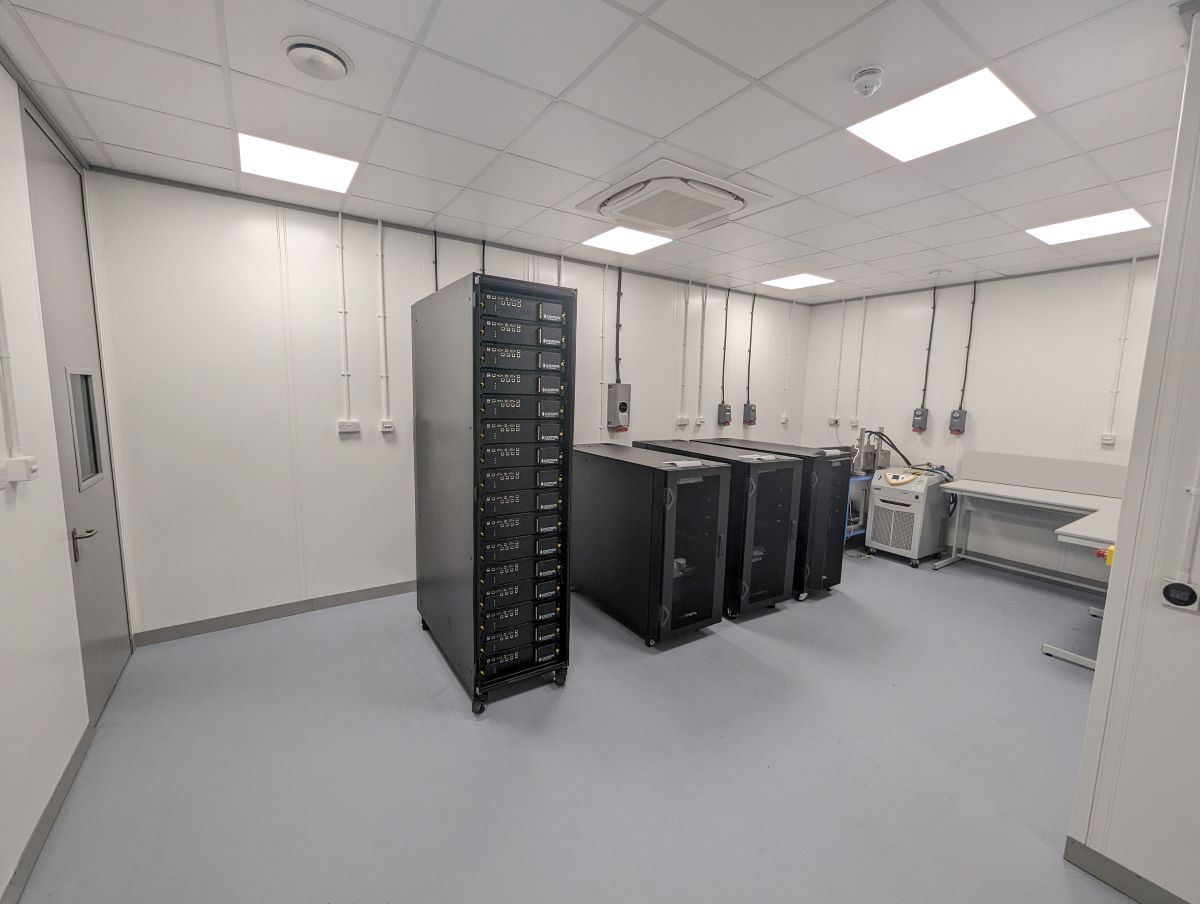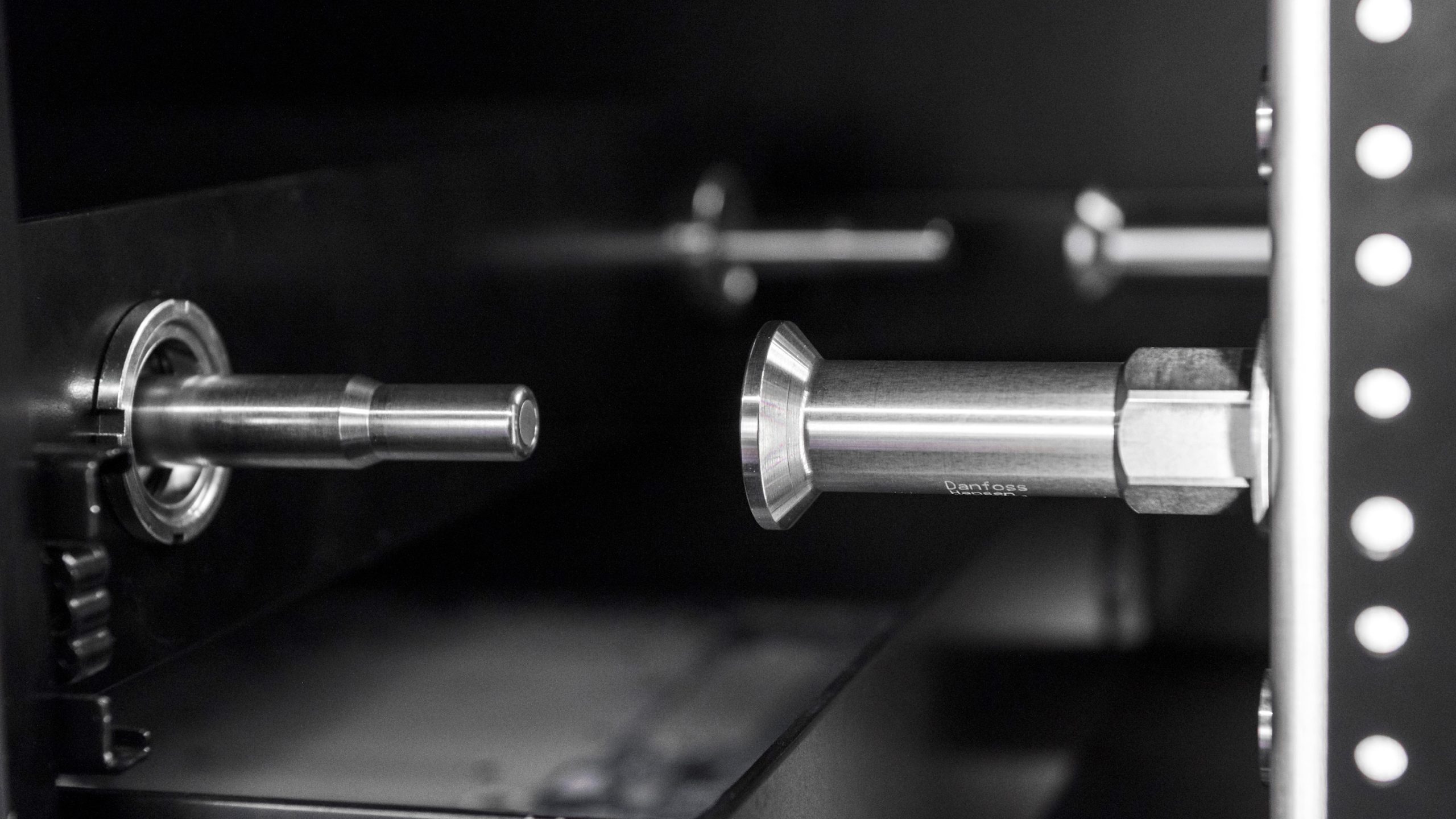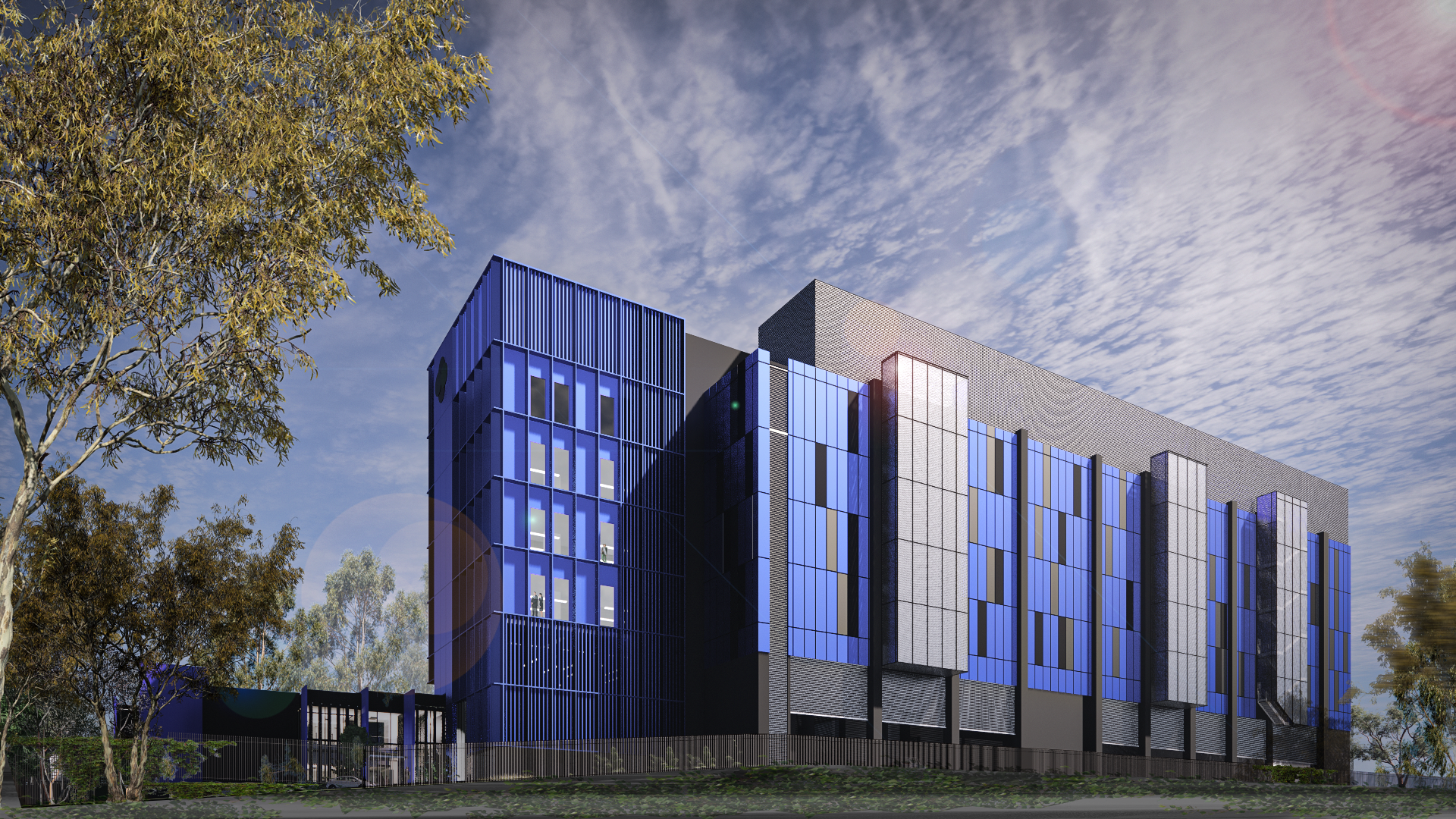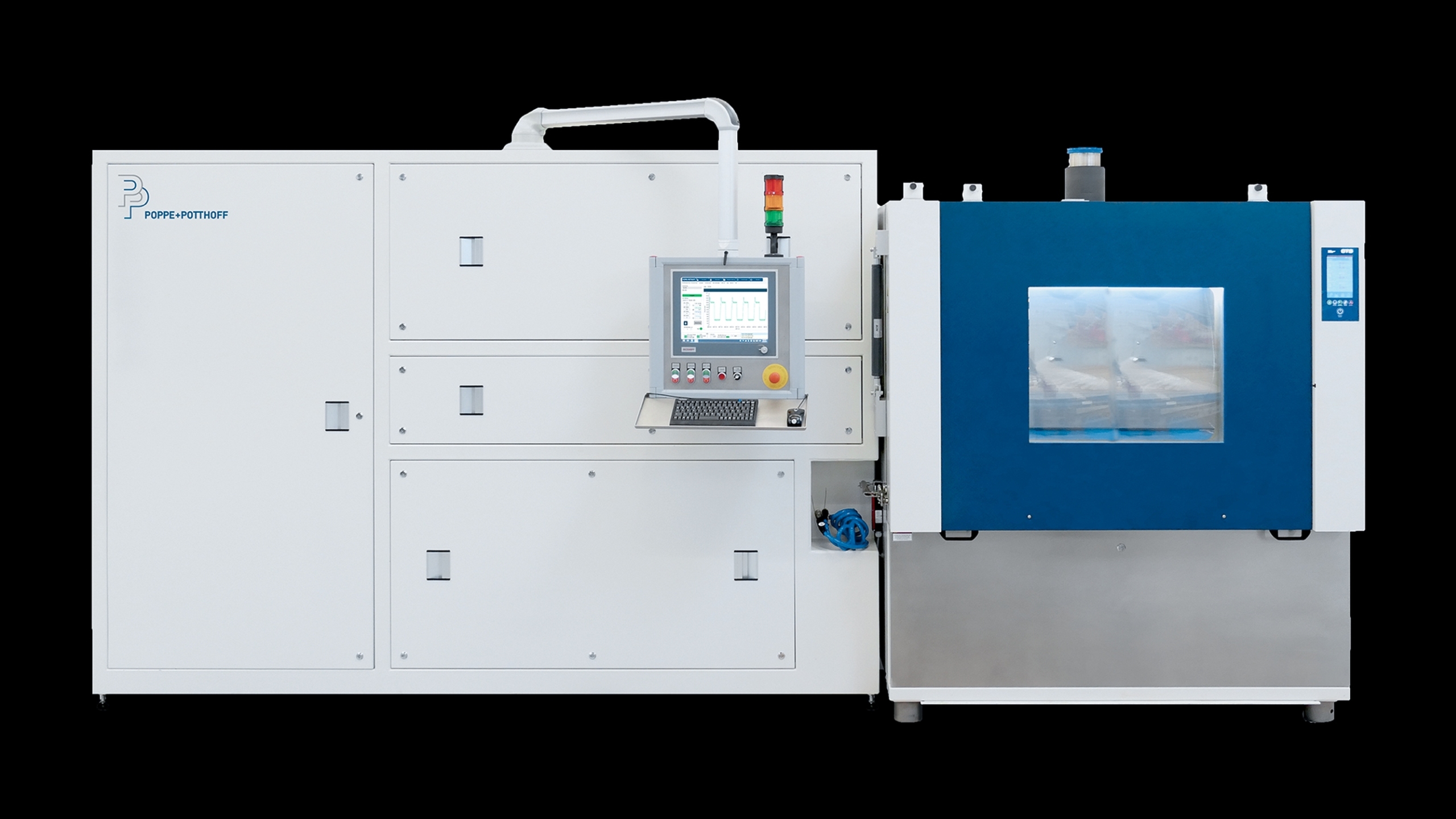Liquid Cooling Technologies Driving Data Centre Efficiency
Cooling
Data Centre Infrastructure News & Trends
Data Centres
Innovations in Data Center Power and Cooling Solutions
Liquid Cooling Technologies Driving Data Centre Efficiency
News
Iceotope launches state-of-the art liquid cooling lab
Iceotope Technologies, a global provider of precision liquid cooling technology, has announced the launch of Iceotope Labs, the first of its state-of-the-art liquid cooling lab facilities in Sheffield.
Designed to revolutionise high-density data centre research and testing capabilities for customers seeking to deploy liquid cooling solutions, Iceotope believes that its Iceotope Labs will set new standards as the industry's most advanced liquid-cooled data centre test environment available today.
Amid the exponential growth of AI and machine learning, liquid cooling is rapidly becoming an enabling technology for AI workloads. As operators evolve their data centre facilities to meet this market demand, validating liquid cooling technology is key to future-proofing infrastructure decisions.
By leveraging advanced monitoring capabilities, data analysis tools, and a specialist team of test engineers, Iceotope Labs will provide quantitative data and a state-of-the-art research and development (R&D) environment to demonstrate the benefits of liquid cooling to customers and partners seeking to utilise the latest advancements in high-density infrastructure and GPU-powered computing. Examples of recent research conducted by Iceotope Labs includes groundbreaking testing for next-gen chip level cooling at both 1500W and 1000W. These tests demonstrated precision liquid cooling’s ability to meet the thermal demands of future computing architectures needed for AI compute.
Working in partnership with Efficiency IT, a UK specialist in data centres, IT and critical communications environments, the first of Iceotope’s bespoke labs showcases the adaptability and flexibility of leveraging liquid cooling in a host of data centre settings including HPC, supercomputing and edge environments. The fully functional, small-scale liquid cooled data centre includes two temperature-controlled test rooms and dedicated space for thermal, mechanical and electronic testing for everything from next generation CPUs and GPUs to racks and manifolds.
Iceotope Labs also features a facility water system (FWS) loop, a technology cooling system (TCS) loop with heat exchangers, as well as an outside dry cooler – demonstrating key technologies for a complete liquid cooled facility. The two flexible, secondary loops are independent of each other and have a large temperature band to stress-test the efficiency and resiliency of a customers' IT equipment if and when required. Additionally, the flexible test space considers all ASHRAE guidelines and best practices to ensure optimal conditions for a range of test setups for enhanced control and monitoring all while maximising efficiency and safety.
"We are investing in our research and innovation capabilities to offer customers an unparalleled opportunity," says David Craig, CEO of Iceotope. “Iceotope Labs not only serves as a blueprint for what a liquid cooled data centre should be, but is also a collaborative hub for clients to explore liquid cooling solutions without the need for their own lab space. It's a transformative offering within the data centre industry."
David continues, “We’d like to thank Efficiency IT for its role in bringing Iceotope Labs to fruition. Its design expertise has empowered us with the flexibility needed to create a cutting-edge facility that exceeds industry standards."
“With new advancements in GPU, CPU and AI workloads having a transformative impact on both data centre design and cooling architectures, it’s clear to see that liquid cooling will play a significant role in improving the resiliency, energy and environmental impact of data centres,” adds Nick Ewing, MD, EfficiencyIT. “We’re delighted to have supported Iceotope throughout the design, development and installation of its industry-first Iceotope Lab, and look forward to building on our collaboration as together, we develop a new customer roadmap for high-density, liquid-cooled data centre solutions.”
Located at Iceotope's global headquarters in Sheffield, UK, Iceotope Labs further expands the location as a hub for technology innovation and enables Iceotope to continue to deliver the highest level of customer experience.
For more from Iceotope, click here.
Simon Rowley - 9 July 2024
Cooling
Data Centres
Liquid Cooling Technologies Driving Data Centre Efficiency
News
New Danfoss connector for liquid cooling applications
Danfoss Power Solutions has launched a Blind Mate Quick Connector for data centre liquid cooling applications.
Compliant with soon-to-be-released Open Compute Project Open Rack V3 specifications, the Danfoss Hansen BMQC simplifies installation and maintenance of inner rack servers while increasing reliability and efficiency.
The BMQC enables blind connection of the server chassis to the manifold at the rear of the rack, providing faster and easier installation and maintenance in inaccessible or non-visible locations. With its patented self-alignment design, the BMQC compensates for angular and radial misalignment of up to 5mm and 2.7 degrees, enabling simple and secure connections.
The Danfoss Hansen BMQC also offers a highly reliable design, the company states. The coupling is manufactured from corrosion-resistant 303 stainless steel and the seal material is EPDM rubber, providing broad fluid compatibility and a long lifetime with minimal maintenance requirements. In addition, Danfoss performs helium leak testing on every BMQC to ensure 100% leak-free operation.
Amanda Bryant, Product Manager at Danfoss Power Solutions, comments, “As a member of the Open Compute Project community, Danfoss is helping set the industry standard for data centre liquid cooling. Our rigorous product design and testing capabilities are raising the bar for component performance, quality, and reliability. Highly critical applications like data centre liquid cooling require 100% uptime and leak-free operation, and our complete liquid cooling portfolio is designed to meet this demand, making Danfoss a strong system solution partner for data centre owners.”
With its high flow rate and low pressure drop, the BMQC improves system efficiency. This reduces the power consumption of the data centre rack, thereby reducing operational costs. Furthermore, the BMQC can be connected and disconnected under pressure without the risk of air entering the system. This eliminates the need to depressurise the entire system, minimising downtime.
The Danfoss Hansen BMQC features a working pressure of 2.4 bar (35 psi), a rated flow of 6 litres per minute (1.6 gallons per minute), and maximum flow rate of 10 lpm (2.6 gpm). It has a pressure drop of 0.15 bar (2.3 psi) at 6 lpm (1.6 gpm). It is available in a 5mm size and is interchangeable with other OCP Open Rack V3 blind mate quick couplings.
For more from Danfoss, click here.
Simon Rowley - 27 June 2024
Cooling
Data Centres
Liquid Cooling Technologies Driving Data Centre Efficiency
News
Schneider experts explore liquid cooling for AI data centres
Schneider Electric has released its latest white paper, Navigating Liquid Cooling Architectures for Data Centres with AI Workloads.
The paper provides a thorough examination of liquid cooling technologies and their applications in modern data centres, particularly those handling high-density AI workloads.
The demand for AI is growing at an exponential rate. As a result, the data centres required to enable AI technology are generating substantial heat, particularly those containing AI servers with accelerators used for training large language models and inference workloads. This heat output is increasing the necessity for the use of liquid cooling to maintain optimal performance, sustainability, and reliability.
Schneider Electric’s latest white paper guides data centre operators and IT managers through the complexities of liquid cooling, offering clear answers to critical questions about system design, implementation, and operation.
Over the 12 pages, authors Paul Lin, Robert Bunger, and Victor Avelar identify two main categories of liquid cooling for AI servers: direct-to-chip and immersion cooling. They describe the components and functions of a coolant distribution unit (CDU), which are essential for managing temperature, flow, pressure, and heat exchange within the cooling system.
“AI workloads present unique cooling challenges that air cooling alone cannot address,” says Robert Bunger, Innovation Product Owner, CTO Office, Data Centre Segment, Schneider Electric. “Our white paper aims to demystify liquid cooling architectures, providing data centre operators with the knowledge to make informed decisions when planning liquid cooling deployments. Our goal is to equip data centre professionals with practical insights to optimise their cooling systems. By understanding the trade-offs and benefits of each architecture, operators can enhance their data centres’ performance and efficiency.”
The white paper outlines three key elements of liquid cooling architectures:
Heat capture within the server: Utilising a liquid medium (e.g. dielectric oil, water) to absorb heat from IT components.
CDU type: Selecting the appropriate CDU based on heat exchange methods (liquid-to-air, liquid-to-liquid) and form factors (rack-mounted, floor-mounted).
Heat rejection method: Determining how to effectively transfer heat to the outdoors, either through existing facility systems or dedicated setups.
The paper details six common liquid cooling architectures, combining different CDU types and heat rejection methods, and provides guidance on selecting the best option based on factors such as existing infrastructure, deployment size, speed, and energy efficiency.
With the increasing demand for AI processing power and the corresponding rise in thermal loads, liquid cooling is becoming a critical component of data centre design. The white paper also addresses industry trends such as the need for greater energy efficiency, compliance with environmental regulations, and the shift towards sustainable operations.
“As AI continues to drive the need for advanced cooling solutions, our white paper provides a valuable resource for navigating these changes,” Robert adds. “We are committed to helping our customers achieve their high-performance goals while improving sustainability and reliability.”
This white paper is particularly timely and relevant in light of Schneider Electric's recent collaboration with NVIDIA to optimise data centre infrastructure for AI applications. This partnership introduced the first publicly available AI data centre reference designs, leveraging NVIDIA's advanced AI technologies and Schneider Electric's expertise in data centre infrastructure.
Schneider claims that the reference designs set new standards for AI deployment and operation, providing data centre operators with innovative solutions to manage high-density AI workloads efficiently.
For more information and to download the white paper, click here.
For more from Schneider Electric, click here.
Simon Rowley - 27 June 2024
Cooling
Data Centres
Liquid Cooling Technologies Driving Data Centre Efficiency
News
New white paper published on liquid cooling for AI data centres
Schneider Electric has released white paper 133 titled Navigating Liquid Cooling Architectures for Data Centres with AI Workloads. The paper provides a thorough examination of liquid cooling technologies and their applications in modern data centres, particularly those handling high-density AI workloads.
The demand for AI is growing at an exponential rate. As a result, the data centres required to enable AI technology are generating substantial heat, particularly those containing AI servers with accelerators used for training large language models and inference workloads. This heat output is increasing the necessity for the use of liquid cooling to maintain optimal performance, sustainability, and reliability.
Schneider Electric’s latest white paper guides data centre operators and IT managers through the complexities of liquid cooling, offering clear answers to critical questions about system design, implementation, and operation.
Understanding liquid cooling architectures
Over the 12-pages, authors Paul Lin, Robert Bunger and Victor Avelar identify two main categories of liquid cooling for AI servers: direct-to-chip and immersion cooling. They describe the components and functions of a coolant distribution unit (CDU), which are essential for managing temperature, flow, pressure, and heat exchange within the cooling system.
“AI workloads present unique cooling challenges that air cooling alone cannot address,” says Robert Bunger, Innovation Product Owner, CTO Office, Data Centre Segment, Schneider Electric. “Our white paper aims to demystify liquid cooling architectures, providing data centre operators with the knowledge to make informed decisions when planning liquid cooling deployments. Our goal is to equip data centre professionals with practical insights to optimise their cooling systems. By understanding the trade-offs and benefits of each architecture, operators can enhance their data centres’ performance and efficiency.”
The white paper outlines three key elements of liquid cooling architectures:
Heat Capture Within the Server: Utilising a liquid medium (e.g. dielectricoil, water) to absorb heat from IT components.
CDU Type: Selecting the appropriate CDU based on heat exchange methods(liquid-to-air, liquid-to-liquid) and form factors (rack-mounted,floor-mounted).
Heat Rejection Method: Determining how to effectively transfer heat to theoutdoors, either through existing facility systems or dedicated setups.
Choosing the right architecture
The paper details six common liquid cooling architectures, combining different CDU types and heat rejection methods, and provides guidance on selecting the best option based on factors such as existing infrastructure, deployment size, speed and energy efficiency.
With the increasing demand for AI processing power and the corresponding rise in thermal loads, liquid cooling is becoming a critical component of data centre design. The white paper also addresses industry trends such as the need for greater energy efficiency, compliance with environmental regulations, and the shift towards sustainable operations.
“As AI continues to drive the need for advanced cooling solutions, our white paper provides a valuable resource for navigating these changes,” adds Robert. “We are committed to helping our customers achieve their high-performance goals while improving sustainability and reliability.”
For more from Schneider Electric, click here.
Carly Weller - 20 June 2024
Cooling
Data Centres
Liquid Cooling Technologies Driving Data Centre Efficiency
News
Data centre cooling market to reach £13.2bn in 2028
According to new research from global analyst, Omdia, the data centre thermal management market has surged to a staggering $7.67bn (£6bn), outpacing previous forecasts.
This unprecedented growth is poised to continue with a robust CAGR of 18.4% until 2028. This surge will largely be fuelled by AI-driven demands and innovations in high-density infrastructure, marking a pivotal moment for the industry.
As AI computing becomes ubiquitous, the demand for liquid cooling has surged dramatically. Key trends include the rapid adoption of Rear Door Heat Exchangers (RDHx) combined with 1-P direct-to-chip cooling, achieving an impressive 65% year-over-year growth, frequently integrating heat reuse applications. This period also sees a strategic blend of air and liquid cooling technologies, creating a balanced and efficient thermal management.
Omdia’s Principal Analyst, Shen Wang, explains, “In 2023, the global data centre cooling market experienced increased consolidation, Top 5 and Top 10 concentration ratios rising by 5% from the previous year. Omdia expanded vendor coverage in its report to include 49 companies, up from 40, adding Chinese OEMs and direct liquid cooling component suppliers. Vertiv, Johnson Controls, and Stulz retained their top three positions, with Vertiv notably gained 6% market share, due to strong North American demand and cloud partnerships.”
Market growth for data centre cooling was primarily constrained by production capacity, particularly for components like Cooling Distribution Units (CDUs), rather than a lack of demand. Numerous supply chain players struggled to satisfy the soaring market needs, causing component shortages. However, improvements forecasted for 2024 are expected to alleviate this issue, unlocking orders delayed from the previous year due to supply chain bottlenecks. During this time, liquid cooling adoption witnessed robust growth, particularly in North America and China, with new vendors entering the scene and tracked companies exhibiting significant expansion.
In this near $1bn (£785m) market of liquid cooling, direct-to-chip vendor, CoolIT, remains the top leader in liquid cooling market, followed by immersion cooling leader, Sugon, and server vendor, Lenovo.
The data centre thermal management is advancing due to AI's growing influence and sustainability requirements. Despite strong growth prospects, the industry faces challenges with supply chain constraints in liquid cooling and embracing sustainable practices. Moving forward, the integration of AI-optimised cooling systems, strategic vendor partnerships, and a continued push for energy-efficient and environmentally friendly solutions will shape the industry's evolution.
Successfully addressing these challenges will ensure growth and establish thermal management as a cornerstone of sustainable and efficient data centre operations, aligning technology with environmental stewardship.
Shen adds, “Data centre cooling is projected to be a $16.8bn (£13.2bn) market by 2028, fuelled by digitalisation, high power capacity demand, and a shift towards eco-friendly infrastructure, with liquid cooling emerging as the biggest technology in the sector.”
Simon Rowley - 19 June 2024
Data Centres
Liquid Cooling Technologies Driving Data Centre Efficiency
News
Macquarie starts construction on Sydney data centre
Macquarie Data Centres has started construction on its IC3 Super West data centre after appointing prominent Australian construction company, FDC Construction (FDC), as the main building contractor. The project will bring more sovereign AI and cloud data centre capacity to Sydney.
IC3 Super West is being purpose built for high-density cloud and AI workloads, including hybrid air and liquid cooling options. The facility is the third and largest addition to the provider's flagship Macquarie Park Data Centre Campus in Sydney’s North Zone and will bring the total campus IT load up to 63 megawatts (MW). IC3 Super West will open its doors with all end state power secured.
The new build is part of Macquarie Data Centres’ wider expansion strategy to meet the increase in demand for capacity from its hyperscale, government and enterprise customers.
David Hirst, Group Executive of Macquarie Data Centres, says: “Sovereign AI and cloud data centres are the backbone of Australia’s AI-driven future. Like all of Macquarie Data Centres’ facilities, IC3 Super West will be Certified Strategic by the Australian Federal Government. This gives our data centres a strong compliance posture as regulations around data sovereignty and AI continue to tighten in Australia and worldwide.
“This partnership brings together two Australian powerhouses with extensive experience in constructing state-of-the-art, mission critical facilities.”
IC3 Super West marks the seventh project between FDC and Macquarie Data Centres, reinforcing the companies' long-standing partnership. Their most recent project was IC3 East, the previous addition to the Macquarie Park Data Centre Campus, which was delivered on time and on budget.
Ben Cottle, Founder, FDC Construction, comments, “Our longstanding partnership with Macquarie Data Centres is testament to the trust and collaboration that exists between both organisations. With the rapid adoption of AI resulting in increased demand for data centres, FDC’s team of experts continue to be at the forefront of delivering scalable, energy-efficient facilities like IC3 Super West that can support the ever-evolving demands of Macquarie Data Centres’ customers.”
IC3 Super West will offer customers AI densities, resilient data halls, dedicated office space and storage. The large-scale project is expected to bring more than 1,200 jobs to the region. The construction cost will be circa $350 million from FY25 to practical completion of phase one, which will deliver the powered core and shell, as well as 6MW of IT load fitted out.
“The widespread adoption of AI is fuelling a new wave of next generation AI infrastructure and GPUs from tech giants such as Dell and Nvidia,” David adds. “These highly dense compute technologies can only live in purpose-built data centres that meet their significant power and cooling requirements. IC3 Super West is being built to cater to this rising demand here in Australia.”
For more from Macquarie Data Centres, click here.
Simon Rowley - 13 June 2024
Liquid Cooling Technologies Driving Data Centre Efficiency
News
Liquid-cooled server components put to the test
Efficient cooling of server racks (colocation) is crucial for data centres in order to ensure the performance and longevity of the hardware. Liquid-cooled systems are becoming increasingly important in this respect, and as a result, German organisation Poppe + Potthoff Maschinenbau (PPM) is developing test benches to examine and optimise the quality of cooling components and systems.
According to current forecasts by the International Energy Agency (IEA), data centres will consume more than 800 terawatt hours of energy worldwide by 2026 - more than twice as much as in 2022. Liquid cooling systems help to improve power usage effectiveness (PUE). They are up to 40% more efficient than conventional air cooling and make a significant contribution to reducing energy consumption and costs.
DLC systems are considered to be particularly efficient. The coolant is in direct contact with heat-generating components in the server rack, which ensures very effective heat dissipation. This method enables high-density data centres, as DLC systems are very compact. As they can cope with higher temperatures than air cooling, fewer fans are required. This not only reduces power consumption and costs, but also noise pollution.
To prevent damage caused by leaks, all media-carrying components of the DLC system must meet the highest requirements in terms of strength and tightness - and also with changing pressures and temperatures. These include the coolant distribution units (CDU), connectors, valves, lines and the cooling plates, inside which the coolant circulates through microchannels. These are installed directly above the heat-producing components such as CPUs and GPUs.
To test the mechanical strength and tightness of DLC components and systems, Poppe + Potthoff Maschinenbau offers test benches for burst and leak tests up to 70 bar (1100 psi), as well as dynamic pressure pulsation tests of up to 20 bar (290 psi). Higher pressures and water hammer tests can also be realised. With sinusoidal and trapezoidal curves in frequencies of up to 2 Hz, all operating conditions can be comprehensively simulated over the service life.
Testing is carried out with water-glycol emulsions or other coolants such as PG25. The media and ambient temperatures in the temperature-controlled test chambers usually vary between -20°C and +90°C (-4°F to +194°F). The simulation of real operating conditions in PPM's test benches makes it possible to minimise failure risks and costs and to ensure optimum performance of all components of the cooling system in interaction.
Simon Rowley - 12 June 2024
Cooling
Data Centres
Liquid Cooling Technologies Driving Data Centre Efficiency
News
STULZ launches new coolant management and distribution unit
STULZ, a global mission critical air conditioning specialist, has announced the launch of CyberCool CMU – an innovative new coolant management and distribution unit (CDU) that is designed to maximise heat exchange efficiency in liquid cooling solutions.
Launched at Data Centre World Frankfurt 2024 earlier this week, CyberCool CMU seeks to offer industry-leading levels of energy efficiency, flexibility and reliability within a small footprint, while providing precise control over an entire liquid cooling system.
"The rapid advancement of high-performance computing, artificial intelligence (AI) and machine learning (ML) has led to a massive increase in data centre rack and server power density," explains Joerg Desler, Global Director Technology at STULZ. "Central processing units (CPUs) and graphics processing units (GPUs) are expected to exceed 1000W per processor or higher in the next few years. These processing requirements are placing tremendous demands on data centre cooling systems, and where liquid cooling was once an option, it is rapidly becoming essential."
CyberCool CMU has been developed to maximise heat exchange by isolating the facilities water system (FWS) and technology cooling system (TCS) elements of a liquid cooling system. This significantly reduces the risk of cross-contamination and leaks, thereby enhancing overall reliability. It also provides precise control over each side of the cooling system, enabling better management of coolant flow rates, temperatures and pressure, which improves overall system efficiency. As it is precision engineered, CyberCool CMU accurately controls the supply temperature and flow rate of the coolant with minimal power consumption.
Comprising premium grade water pumps, plate heat exchangers, water valves and controllers, CyberCool CMU provides a reliable and efficient liquid coolant supply. High liquid coolant quality is ensured through sanitary grade stainless-steel pipelines, and to enhance system compatibility the unit offers a range of structural, electrical and control options including the flexibility to accommodate customer specific configurations and power loads. Alongside a series of standard unit configurations and capacities, this new product line from STULZ can offer a high level of customisation, adapting to specific needs in the DLC market.
Data centres are under increasing pressure to become more sustainable, so CyberCool CMU is designed to seamlessly integrate with ancillary STULZ A/C products, providing an efficient system solution throughout; as well as supporting ASHRAE’s guidelines for water cooling specifications. To achieve the highest standards of reliability and usability, CyberCool CMU’s software and hardware are perfectly harmonised with any liquid cooling solution, while its intuitive touchscreen display provides clear menu navigation. Multiple variable speed pumps provide adaptation to required liquid flow rates alongside energy efficiency gains as well as build in redundancy.
Joerg concludes, "The transition to liquid cooling in data centres is well underway and we are confident that CyberCool CMU can meet the heat transfer demands of these systems sustainably, efficiently, reliably and flexibly."
For more from STULZ, click here.
Simon Rowley - 24 May 2024
Cooling
Data Centres
Liquid Cooling Technologies Driving Data Centre Efficiency
Modular Data Centres in the UK: Scalable, Smart Infrastructure
News
Sonic Edge partners with Iceotope to launch dedicated AI Pods
Sonic Edge, a provider of modular data centres (MDCs), is partnering with Iceotope, a global precision liquid cooling expert, to launch new Iceotope AI Pods.
Sonic Edge provides a range of Edge and HPC (High-Performance Computing)-ready MDCs that enable organisations to run their operations anywhere in the world. With the significant increase in the compute densities required for AI applications, Sonic Edge recognised the opportunity to design and build containerised MDCs, or Pods, that are AI application-ready, incorporating advanced precision liquid cooling technology from Iceotope.
The resulting Iceotope AI Pods are multi-tenant MDCs with a capacity of up to 450kW, a 12x4m footprint, and can be deployed either on-premise, or in remote locations. They are designed to include everything you would find in a standard data centre facility, such as UPS backup, fire suppression, and monitoring and evaluation.
Stuart Priest, Founder and CEO, Sonic Edge, explains, “There are many organisations, particularly start-ups, that can’t afford to wait for colocation space to become available for their operations. They are looking to get their own high-performance, AI-ready MDCs up and running fast. We’re excited about our collaboration with Iceotope because we can now provide cloud or edge providers with multi-tenant Pods that have Iceotope’s advanced precision liquid cooling built in.”
David Craig, CEO, Iceotope, adds, “We’re seeing an unprecedented surge in data generation and the evolving role of data centres as interactive AI powerhouses. To meet this demand – and with scalability, serviceability, and sustainability at the forefront of industry demands – our precision liquid cooling is pivotal to providers such as Sonic Edge. We are delighted to be partnering with them to have our technology incorporated into fast and easy-to-deploy Pods to facilitate high-performance AI.”
Rapid implementation and cost-effectiveness are major benefits of the AI Pods, according to Stuart Priest. He notes, “To build and get a data centre up and running can take five or six years, whereas with an AI Pod it takes just 16 weeks from order to delivery. Everything needed to make it operational is there from day one, and we offer ‘tier three ready’ as standard. We also ensure that the Iceotope AI Pods adhere to all relevant industry compliance standards. The highest levels of security can also be incorporated, ranging from SR1 to SR8.”
Flexibility is at the heart of the Iceotope AI Pods. Stuart continues, “Our Pods are meticulously designed to adapt seamlessly to customers’ growing requirements. We believe in building a solution to fit the project, rather than trying to fit the project into the solution. With Iceotope AI Pods, you can literally ‘pay as you grow’.”
For more from Iceotope, click here.
Simon Rowley - 21 May 2024
Cooling
Data Centres
Liquid Cooling Technologies Driving Data Centre Efficiency
News
LiquidStack opens new facility to scale liquid cooling production
LiquidStack, provider of liquid cooling solutions for data centres, has announced its new US manufacturing site and headquarters located in Carrollton, Texas. The new facility is a major milestone in its mission to deliver high performance, cost-effective and reliable liquid cooling solutions for high performance data centre and edge computing applications. With a significant uptick in liquid cooling demand associated with scaling generative AI, the new facility enables it to respond to customers' needs in an agile fashion, while maintaining the standards and services the company is known for.
LiquidStack’s full range of liquid cooling solutions are being manufactured on site, including direct-to-chip Coolant Distribution Units (CDUs), single phase and two phase immersion cooling solutions and the company’s MacroModular and MicroModular prefabricated data centres. The site will also host a service training and demonstration centre for customers and its global network of service engineers and partners.
“We are seeing incredibly high demand for liquid cooling globally as a result of the introduction of ultra-high TDP chips that are driving the scale and buildout of generative AI. Our investment in this new facility allows us to serve the rapidly growing market while creating new, high-skilled jobs right here in Carrollton,” says Joe Capes, CEO, LiquidStack.
The new manufacturing facility and headquarters occupies over 20,000sqft. It has also been in operation since December 2023, and a formal ribbon cutting ceremony will be held on March 22, 2024. Expected attendees include members of the city council and the Metrocrest chamber of commerce, as well as LiquidStack customers and partners.
Isha Jain - 5 March 2024

Head office & Accounts:
Suite 14, 6-8 Revenge Road, Lordswood
Kent ME5 8UD
T: +44 (0)1634 673163
F: +44 (0)1634 673173









